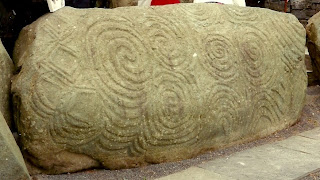Today is one of my most favourite days on the calendar - December 21 - the Winter Solstice. It marks the longest night of the year as well as the point at which the sun (sol) stops (stit) moving south. Which means with the sunrise tomorrow, the sun will begin its journey back north, which means light and warmth return. No wonder the ancient ones celebrated the solstice. I'm celebrating it too!
When I first learned of Newgrange in County Meath, Ireland forty years ago, it was in an article about the winter solstice - how the rising sun shone through a roof-box and illuminated the passage and chamber of this 5,000 year old tomb. Oh, how I wanted to see that for myself. Of course to be one of the ones to see the rising sun flood the chamber with light on the solstice, you literally have to win the lottery which only a few each year, do. But, because I visited Newgrange in September, nineteen years ago, I was able to stand in line for a turn to enter the passageway and view the burial chamber.
The picture I took of the carved entrance stone as I waited in line. This megalithic stone is about ten feet long and four feet wide - estimated to weigh five tons.
A path encircles the ancient Newgrange mound. This is a picture I took on the backside.
And this is a photo I took of one of the engraved kerbstones along that walk around the mound.
Also on the backside of the entrance to Newgrange was this stone structure. At the time of my visit I did not learn what it was. Thanks to the internet, I now know it is a 'folly' built in the 1800's. A folly is "an ornamental building with no practical purpose, esp. a mock-Gothic ruin built in a garden or park. I'm glad to finally understand what this was. It was built with stones taken from the Newgrange mound.
There are two other passage tomb mounds in this same area, Knowth is pictured above along with some of its eighteen 'satellite' tombs (the small mounds). Excavations at this site were just beginning when I was there.
The other noted mound is Dowth, part of which is evident on the right in this photo. To the left is the home and memorial of John Boyle O'Reilly - poet, journalist and member of the Irish Republican Brotherhood (Fenians). His poem, A White Rose, was always a favourite of mine:
"The red rose whispers of passion, and the white rose breathes of love; Oh the red rose is a falcon, and the white rose is a dove. But I send you a cream-white rosebud, with a flush on its petal tips; for the love that is purest and sweetest, has a kiss of desire on the lips."
All three of these megalithic tombs lie in the beautiful Boyne River Valley. This photo, taken from the front of Newgrange, looks toward the Boyne River about a mile away. You may remember learning about "The Battle of the Boyne", a well-known battle in the history of the British Isles.
"I would fly to the woods' low rustle and the meadows' kindly page. Let me dream as of old by the river, and be loved for the dream alway; for a dreamer lives forever, and a toiler dies in a day." (from 'The Cry of the Dreamer' by John Boyle O'Reilly - said to be JFK's favourite poet.)
However, wherever you celebrate the solstice, may you enjoy the return of light.









No comments:
Post a Comment